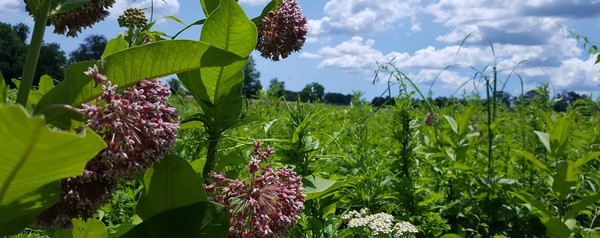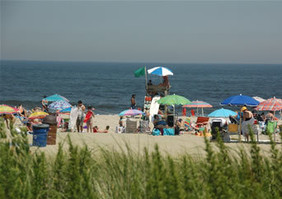 Common milkweed, Asclepias syriaca, in bloom at Dorbrook Recreation Area, Colts Neck. Source: Amber Mallm.

Monmouth County Environmental Newsletter: July 2019
|
|
|
|
Having trouble viewing this email? View it as a Web page.
|
|
|
|
 Roundtable Offers Guidelines for Tick & Mosquito Protection
On June 5, in preparation for the summer season, the Monmouth County Environmental Council (MCEC) hosted a roundtable titled Ticks and Mosquitoes in Monmouth County: Resources to Help You Protect Your Family and Pets. The MCEC brought together a panel of speakers to address the threat of ticks and mosquitoes. Attendees heard from Christopher Merkel, Public Health Coordinator of the Monmouth County Division of Health, Dr. Deborah Breitstein, Veterinarian and Co-Owner of Animal Healthcare of Marlboro, Dina Fonseca Ph.D., Rutgers Center for Vector Biology and Victoria Thompson, Superintendent of the Monmouth County Mosquito Control Division.
Attendees received an overview on which types of ticks and mosquitoes are prevalent in Monmouth County, the diseases they spread, a history of vector-borne diseases and surveillance and control efforts led by the County. Each speaker emphasized the best defense against vector-borne diseases is to avoid being bitten. Guests were advised to wear protective clothing like long sleeves, pants and tall socks when in tick habitats, use EPA-recommended insect repellents like Picaridin, DEET >25%, IR3535, oil of lemon eucalyptus, to replace any missing or damaged window screens and to maintain yards to discourage tick and mosquito habitat. To protect pets from mosquitoes, ticks and fleas, apply topical repellents appropriate for your pet, check pets for ticks and remove any ticks as soon as possible. Attendees were advised if someone in your family is showing flu-like symptoms, immediately seek medical attention. Similarly if your pet is lethargic, has loss of appetite, vomiting, or shows other signs of sickness, see your veterinarian.
The MCEC also debuted its new Eco-Tips Brochure: Dealing with Ticks and Mosquitoes. The guide outlines which types of ticks and mosquitoes are common in the County, the diseases they can spread, steps one can take to avoid tick and mosquito bites and County resources. To view this Eco-Tips brochure and others, click here.
|
|
Upcoming Environmental & Outdoor Events in Monmouth County:
Some activities may require registration and/or fees
- All-Month-Long, Mondays, Wednesdays, and Fridays, 11 a.m. -12 p.m. Seining Along Sandy Hook Bay, Bayshore Waterfront Park, Port Monmouth
- Every Tuesday, "Tidal Tuesdays," 11 a.m., Fisherman's Cove Conservation Area, Manasquan
-
Every Wednesday, Fishing 101, 10 a.m. -2 p.m. Manasquan Reservoir, Howell
- Every Saturday & Sunday, Birding on the Deck, Sandy Hook Lot M Observation Deck
- July 9, 8:30 p.m. Stars of Sandy Hook, Sandy Hook Lot E
- July 11, 6:00 p.m. Monmouth County Audubon Society Bird Walk, Sandy Hook Lot M
-
July 16, 7:30 -9:00 p.m. Night Hike-Full buck Moon, Sandy Hook Lot E
- July 17, 10 a.m. -1 p.m. or 1:30 p.m. -4:30 p.m. NJ Clean Energy Master Plan Stakeholder Meeting, Trenton
- July 24-28, Monmouth County Fair, Freehold
|
|
|
Division of Planning and NWS Earle Partnership Recognized

The Monmouth County Division of Planning was recently awarded the Rutgers Sustainable Raritan River 2019 Government Innovation Award for its partnership with Naval Weapons Station Earle (NWS Earle). The partnership consists of multiple efforts including the 2017 Joint Land Use Study (JLUS), a Readiness and Environmental Protection Integration (REPI) program grant , and the Raritan/Sandy Hook Bay Coastal Resilience Planning Study.
The Monmouth County JLUS for NWS Earle sought to create land use strategies for compatible development alternatives that could help keep the base operational while protecting the environmental sustainability of the surrounding municipalities. The JLUS was the first of its kind in the nation to focus on climate adaptation planning. Completion of the JLUS led to $2,065,070.59 in federal REPI funding, which will allow the permanent preservation of farmland and open spaces around Earle to protect the station’s mission, improve water quality, protect water supply, enhance habitat restoration and improve both resiliency and stormwater management. The ongoing Raritan/Sandy Hook Bay Coastal Resilience Planning Study seeks to to identify 10-12 projects to improve resilience at the NWS Earle waterfront and in the surrounding communities. Once the Technical Advisory Committee completes the site selection process, the consultant team from Michael Baker International will prepare concept plans, list necessary permits and potential funding sources.
The Rutgers Sustainable Raritan River Initiative began in 2009 to assemble concerned environmental professionals, businesses and governments to craft an agenda that met the standards of the U.S. Clean Water Act to restore and preserve New Jersey’s Raritan River, its tributaries and its bay. The Initiative partners with other Rutgers schools, centers and programs to ensure the best contributions from sciences, planning and policy. Each year at their annual conference, they recognize outstanding achievements to revitalize the region, restore and protect resources and promote the watershed as a great place to live, work or raise a family.
|
NJ Board of Public Utilities Releases 2019 Draft Energy Master Plan
In June, the New Jersey Board of Public Utilities (NJBPU) released the 2019 Draft New Jersey Energy Master Plan. The Plan is designed to achieve Governor Murphy’s goal of 100% clean energy by 2050 and the Global Warming Response Act’s goal to reduce State greenhouse gas emissions to 80% below the 2006 level by 2050. The plan focuses on meeting the goals through 100% carbon-neutral electricity production and through electrification of the building and transportation sectors, the two highest carbon emission producing sectors in the State.
To reach these goals, the plan identifies seven main strategies. Strategy one focuses on reducing energy consumption and emissions in the transportation sector. Strategy two promotes the development of renewable energy. Strategy three aims to maximize energy efficiency, conservation and to reduce peak demand. Strategy four plans to reduce energy use and emissions from the building sector. Strategy five seeks to modernize the grid and utility infrastructure. Strategy six supports community energy planning and action in low and moderate income environmental justice communities. Strategy seven focuses on expanding the clean energy innovation economy. Read the Draft EMP.
The Final 2019 EMP will include the findings of the Integrated Energy Plan, currently being developed, as well as other studies and specific dates and metrics. NJBPU is hosting multiple stakeholder meetings to gather comments. Attend a stakeholder session on July 17 in Trenton, August 8 in Newark and September 12 in Camden, or submit a comment by using the subject line “2019 Draft Energy Master Plan” here. Comments are due by September 16.
|
|
2017 Agricultural Census County Profile
 Horses at Perretti Farms, Upper Freehold. Source: Harriet Honigfeld
The 2017 Agricultural Census identified 838 farms in Monmouth County, which shows a 2% increase since 2012 and reported 39,198 acres in farming, which demonstrates a 1% increase since 2012. Roughly 39% of all Monmouth County farms are preserved. Monmouth County is a leading seller of horses, ponies, mules, burros and donkeys. The County is ranked first when compared to the 19 counties producing in the State and is ranked 13th when compared to the 2,970 counties producing across the U.S. The County is also ranked second in the State in sales of nursery, greenhouse, floriculture and sod. Overall, Monmouth County is ranked eighth in the State for market value of products sold and contributes 7% to total State agriculture sales. View the County Profile here or access all of the 2017 Census documents here.
|
|
Monmouth County & NJDEP Commence Summer Beach Monitoring
 Seven Presidents Ocean Front Park is monitored by the CCMP. Source Monmouth County Park System
Each summer the NJDEP, Monmouth County Department of Health and other health agencies partner to form the Cooperative Coastal Monitoring Program (CCMP) to monitor potential enterococcus bacteria at bathing beaches. Every week, 46 stations are monitored for enterococcus bacteria. A sample that exceeds 104 parts per 100 ml of water triggers an advisory and requires a second sample. If a second sample results in greater than 104, the CCMP will close the beach until a sample deems the water as safe. The CCMP also offers data on rip currents, surf forecasts and clinging jellyfish sightings along the shore. View sampling results and stay up to date on beach advisories and closings by visiting the CCMP website.
|
|
|
|
|
|
|
NJ FRAMES to Host Public Open House for Two Rivers Communities
New Jersey Fostering Regional Adaptation through Municipal Economic Scenarios (NJ FRAMES) is a regional collaborative project that seeks to understand and address future flood vulnerability along the Navesink and Shrewsbury Rivers, otherwise known as the Two Rivers. NJ FRAMES is comprised of representation from municipalities within the Two River region, local research organizations, non- profits, academic institutions, Monmouth County Division of Planning and Office of Emergency Management and NWS Earle in partnership with NOAA, NJDEP, Rutgers University and WSP (formally Louis Berger). Ultimately NJ FRAMES will result in the development of a long-term Regional Resilience and Adaptation Action Plan to identify ways the region can reduce risks and impacts of future flooding.
NJ FRAMES is hosting a public open house for residents from the 15 towns in the study area to learn about the project and provide feedback on how to help make their community and the region more resilient. Those who live, work and/or visit the region are encouraged to join! The event will take place on July 10, from 4 to 7 p.m. at the Middletown Arts Center. Participants can come at any point during the three hour event window.
NJ Section of the American Water Resources Association Seeking Nominations
The NJ Section of American Water Resources Association (NJ-AWRA) is seeking nominations for its annual Excellence in Water Resources Protection and Planning Awards. It is NJ-AWRA's mission to advance water research, planning, development, management and education by sharing ideas and information in the field of water resources science and technology.
NJ-AWRA will recognize up to three projects that serve as outstanding examples of water resource projects in N.J. Projects may be focused on stormwater or groundwater management or ecological restoration, should incorporate partnerships among stakeholders, and must be recently completed or nearing completion. Applications are due July 19. To learn more about NJ-AWRA, the award criteria and to access application form, click here.
AGU Thriving Earth Exchange Seeking Community Science Projects
The American Geophysical Union (AGU) is seeking several U.S. communities for its Thriving Earth Exchange project (TEX) September cohort. AGU is an Earth and space science membership society of over 60,000 members who study everything from the center of the Earth to the surface of the Sun and everything in between. Through the TEX program, AGU pairs a volunteer scientist with an interested community group to advance a community's priorities in climate resilience, pollution, natural resource management or natural hazards. Recently TEX worked with a community group called OC Flooding in Ocean City to identify flooding issues and to work towards completing a comprehensive flood remediation plan. Read about the Ocean City project here.
For more information about the Thriving Earth Exchange program or to apply to be considered in the September cohort click here. Applications will be considered for the September cohort on a rolling basis until August 16. Applications will also be considered on a rolling basis for a December cohort until 15 November 2019.
NJDEP Denies NESE Permits
Over the past few months, the Monmouth County Board of Freeholders signed a resolution opposing the Northeast Supply Enhancement pipeline (NESE) and the New York Department of Environmental Conservation denied permits for the project. Now NJDEP has issued a notice of denial for multiple permits. Due to sediment sampling analysis that indicated proposed dredging could adversely impact surface water quality through re-suspension of phenanthrene, arsenic, manganese, mercury, PCBs and pesticides NJDEP denied the Waterfront Development Individual Permit and Water Quality Certificate for the proposed Raritan Bay loop pipeline along the Raritan bay floor. NJDEP deemed that Transco did not provide modeling to show that turbidity and levels of the contaminants of concern meet surface water quality standards or demonstrate how it would mitigate impacts. NJDEP also denied the Freshwater Wetlands Individual permit and Flood Hazard Area permit for the proposed compressor station in Middlesex County. Transco may resubmit for the referenced permits, but it must demonstrate how it would comply with the necessary standards.
Grown in Monmouth Offers a Host of Ways to Enjoy Summer in the County
 Long Beach Pier Village Farmers Market is one of many places to visit this summer. Source: Grown in Monmouth
Monmouth County is home to plenty of ways to shop, eat and play locally this summer. To find out what Monmouth County has to offer, visit growninmonmouth.com. Use the interactive directories to find farmers markets, restaurants, nurseries, community gardens, pick-your-own farms, community supported agriculture farms, wineries, breweries and distilleries throughout the County. This year, more farmers markets were added to the directory, making a map that shares more places to buy locally grown tomatoes, peppers, squash and more.
The guide also highlights the first ever Grown in Monmouth Restaurant Week. From July 28 through August 4, participating restaurants will feature at least one dish on their menus made with ingredients grown in Monmouth County. Any restaurant that uses ingredients grown in Monmouth County is invited to participate. Those interested in registering their restaurant may contact the Division of Economic Development via email or by phone at 732-431-7470. Be sure to go to growninmonmouth.com to see where you can dine during Restaurant Week.
About This Newsletter
The purpose of the newsletter is to inform Monmouth County citizens on the health of their environment and list environmental outreach events in their community. The newsletter is produced by the Monmouth County Division of Planning Section of Environmental & Sustainability Planning in coordination with the Monmouth County Environmental Council. The County of Monmouth and the Board of Chosen Freeholders do not necessarily share the viewpoints of any environmental group mentioned in this newsletter.
If you have questions, comments, or wish to have an event listed in the newsletter, please contact: Amber.Mallm@co.monmouth.nj.us
|
|
|
|